![[Metroactive News&Issues]](http://metroactive.com/gifs/news468.gif)
[ Silicon Valley | Metroactive Home | Archives ]
I Gotta Rite: Patricia Corrales was a dancer for this year's festival
of Quetzalcoatl in May. She's part of an 'indigenous peoples' movement that
has crossed over from purely cultural activities to identity politics.
Montezuma's Revenge
An indigenous' movement active in Silicon Valley is embracing Aztec culture and claiming not to recognize U.S. borders. Will radical identity politics energize a new generation of activists, or just turn off the mainstream?
By Vrinda Normand
Smoke swirls around Nauhxayacatl as she glides throughout the circle of Aztec dancers. Amid quivering headdress feathers, rattling seed pods on active ankles, and pulsing drum beats, she cleanses the ceremonial space with a bowl of burning incense.
Nauhxa purifies everyone that enters the circle and feels for unclean areas to smudge. It's almost like using a sixth sense, she says, to keep the invisible energy field flowing.
The 26-year-old east San Jose native possesses the grace and solemnity of an ancient priestess—with her large brown eyes, delicately hooked nose and full lips, it's easy to believe her when she describes herself as a descendant of the indigenous people who ruled Mexico more than 500 years ago.
Realizing what Nauhxa calls her true identity has been a healing process, she says, for the wounds her people have suffered since being colonized by the Europeans.
"It's like finding yourself from what you have inside," she explains, pointing at her chest. "All the answers you need are right where you started."
The problem, according to Nauhxa, is that many of her people have forgotten who they are. They call themselves Hispanics or Mexican-Americans and think those who cross the man-made border between the United States and Mexico are immigrants.
But Nauhxa believes the border crossed her, not the other way around. Mainstream culture, she says, tells her people to jump into the melting pot without asking hard questions like, "Weren't we here first?"
Your Country, My Aztlan
More than 50 people crowd the Centro Aztlan Chicomoztoc, a downtown San Jose community center named for the "People of Aztlan," or the mythical homeland of the Aztecs that is now the American Southwest. As the smell of homemade corn tortillas pervades the air, the audience sits enraptured for over three hours on this April evening to hear one man speak.
That man is Ocelocoatl, a Mexica (Mechika) elder or expert in Aztec culture. A local Aztec dance group flew him to San Jose from Mexico for a lecture tour, the kind he has been doing in North and South America and Europe for the past 13 years.
His mission: to reawaken the indigenous identity and unite the Mexica people across the continent. He's not interested in borders, he says. He introduces himself in Nahuatl, the native language of the Aztecs, and commences in Spanish to the roomful of Latinos.
"I ask you to think carefully about the knowledge you are about to receive," he says.
He begins talking about how the Europeans brought two weapons to conquer the natives: the sword and the cross. Ocelocoatl speaks slowly and deliberately about the pain inflicted by those weapons. Literally. He describes instruments of torture that were used on the Aztecs, to the point where audience members begin to squirm.
"Their only crime was thinking differently," he says. His words are strong, but his demeanor unthreatening; he flashes a wide, white smile and gazes under thick eyebrows dotted with gray. His long black hair is tied back in a braid.
"When I speak of this," he continues, "it is not my intention to offend anyone. I can't touch your faith. But you need to know what they did to our people. Each and every one of us is a direct descendant of those people."
He tells the audience that they are neither Hispanic nor Latino. They only speak Spanish because it was imposed on them.
"Our history has been distorted," he says. "We need to change the structure of the educational system to spread the real knowledge."
Hours of this talk pass and no one leaves the room. One audience member asks, "So what do we do now?"
Ocelocoatl answers, "This is an intellectual war. We need to develop an awareness of who we are. We need to see, feel, think, believe and create with that identity. If not, there will just be more of the same."
He ends with a call for self-determination, but his message is clearly threatening to many far more mainstream aspects of Latino culture, particularly Catholicism.
"It's hard for the [Latino] community to see a group that threatens the stronghold of the church," says Tamara Alvarado, director of Movimiento de Arte y Cultura Latinoamericana (MACLA).
'You Guys Are Praying to the Devil'
While many religious Latinos may respect Aztec dancing from a distance, some have been clearly opposed to the spiritual elements of the art form.
In 1995, when the local Aztec scene was in its early stages, dancers discovered just how strong this opposition could be.
That year, they honored the unveiling of the Quetzalcoatl statue in downtown San Jose. The city planned the event with the guidance of an Aztec expert, Andres Segura, who has since passed on. Dancers came from all over California to participate, but the community was still new and disorganized. They weren't prepared for the backlash.
Lidia Doniz Tlahuixaya remembers protesters showed up at the ceremony reading Bibles aloud. Some even threw needles and broken glass at the dancers, calling them devil worshippers.
Elena Barron says most Catholic Chicanos react politely to her involvement, but she wonders how many of them think differently under the surface. In the second grade class that she teaches, a student once told her, "You guys are praying to the devil when you use that smoke."
"I know he heard that from his mom," she says.
Before the movement "rolls like the Aztec wheel," as Ocelocoatl says, people must join. But how will a radical minority promote an alternative to a religious institution that has been around for hundreds of years?
Well, for starters, the way many in the Mexica community see it is that the indigenous way of life prevailed for thousands of years before that.
And that for millennia there were no borders.
"The descendants of foreigners are trying to stop something that is very natural to this land," says Adam Gonzales Mitlalpili, the leader of a San Jose Aztec dance and cultural group called Tonalehqueh. The eagles, the whales and the butterflies travel across the border every year, he adds. Why shouldn't his people be allowed to do so?
For obvious reasons, this issue cuts to the core of the immigration debate—and, many believe, puts that debate into a historical context that is usually taboo.
"People against immigration tend to look at the issue in a vacuum, disregarding thousands of years of migratory patterns," says San Jose City College professor Jesus Covarrubias.
On the other hand, Aida Hurtado, a social psychology professor at the University of California, Santa Cruz, points out that the indigenous identity is not as simple as the Mexica movement would like to portray it. For one thing, the movement highlights only one line of heritage, when very few Mexicans or Latinos are purely indigenous. And because it's been so long since the Aztec empire existed, biological claims of native heritage tend to be less factual.
Still, Hurtado says, claiming ancestral rights to what we call "America" is something only descendants of native peoples can do. This relatively new country was created by foreigners who then had to rely on government to define citizenship (instead of the more traditional system of tracking lineage).
"That's why cultural and ancestral claims seem so at odds with the way we think about citizenship now," Hurtado says.
Indeed, the attempt to establish a "white native" identity is back in vogue. Authors like Victor Davis Hansen and Samuel Huntington argue that the influx of Mexican immigration threatens the Anglo Protestant culture that American society is "founded on." In books like Mexifornia, they attempt to stir up fears that Mexicans are trying to "take back" their land and are basically doing so by populating the United States.
Liberation How?
So doesn't this "modern Aztec" movement play into those very fears? Are the Mexica people suggesting a takeover? Not quite.
There are more extreme voices within the movement, but they're basically all talk. One Mexica movement website, www.mexica-movement.org, could very well be construed as militant; the authors lay out a plan for the "liberation of our people" who are victims of the "European beast." But there's a twist: ultimately, the plan concludes that this "liberation" is educational not political.
The primary challenge of the movement is to overcome "500 years of European-enforced ignorance on our people," the site says, although it also reeks of racist overtones, calling European DNA a relic of rape and a "cancer on our people."
Local members of the Mexica community tend to be less extreme. Many say they have grown past an angry stage and have realized that a negative approach isn't the best way to attract followers.
At the Centro Aztlan Chicomoztoc, Quetzaoceloaciua runs the Barrio Defense Committee, an activist organization that applies the historical Mexica perspective to modern issues. A cycle of violence that started with the conquest, she believes, continues today in the form of police brutality, prison conditions and poverty.
She aims at what she calls the root cause of oppression. "We are living in our own homeland that has been stolen from us," she says. "We are living under the boot of a government that has committed genocide against our people." The state of colonization, Quetza says, must change, but that can only happen if "La Raza" wake up to who they really are. "Then we can take on the struggle with confidence and self-determination," she says.
Questioning the mainstream view of race and nationalism led Nauhxa to where she is now, an educator of South American native culture. She was born as Maria and adopted her Aztec name a few years after she moved out of her parents' house at age 15.
Her Mexican immigrant parents couldn't understand why she rejected the Catholic faith. She couldn't understand why they spent more time watching television than being with her. She felt so stifled at home that she left, rented a room and worked her way through high school.
In the beginning, she went through a period of anger as she came to believe that the history books had distorted her ancestors' legacy. She would wear all black and shun other teenagers.
When she joined an Aztec dance group, though, she found acceptance in a community that embraces the ancient ways and, in many ways, views the outside world much like she does.
Nauhxa rarely watches movies or television; the flea market is her mall and she'd rather attend a cultural lecture than party at a club. In reviving her ancestors' customs, she pierced her septum (the membrane between the nostrils) and stretched her earlobes to fit thick jade earrings. She keeps her waist-length black hair in a braid and wears long skirts with brightly colored patterns.
Her new way of life comes with a simple, more inclusive label that embraces South American immigrants, Latinos, Chicanos and even other Native Americans. They're all indigenous people.
Claiming a New Identity
This consciousness seems to be gaining popularity among young adults. Covarrubias of SJCC says that more of his Latino students are drawn to their indigenous identity. "They see it as spiritually uplifting," he explains, "because so many young people are criminalized by mainstream society."
Al Cross teaches American Indian history at San Jose City College and has observed the same trend. "Many urban kids are eager to learn about their backgrounds," he says, because the native identity often gets "washed out" in Californian diversity.
Interestingly, the political overtones that the Mexica movement carries didn't arouse skepticism in over a dozen local Latino professors and community leaders. Some were careful to add that many immigrants and Chicanos are very patriotic but still remember that part of the United States used to be Mexico.
"I think it's something that resonates with a lot of Chicanos because they live in an in-between world," says San Jose State University professor Marcos Pizarro. "People don't tend to see them as Americans and they don't really see themselves as Mexicans. Accepting an indigenous identity is a way to make sense of it all."
At the Washington United Youth Center in San Jose, the thunderous vibration of four large drums and at least 200 feet pounding on the wooden floor reverberates through the bleachers. The weekend festival in honor of the Aztec god Quetzalcoatl in May has attracted dancers from eight groups in San Jose, as well as San Francisco, Oakland and Southern California.
On Saturday, the ceremonial circle fills the gym at the youth center, headdress feathers reaching as high as the basketball hoops. Copal incense clouds the air with a pungent scent as the dancers move continuously for hours on end. The aerobic style involves complex footwork, twisting, squatting and hopping. Every step adds to the percussion because all of the dancers wear rattling ankle belts made with the pods of a large brown seed.
Most of the men wear only loin belts and collars, some with feather bands around their wrists and arms. Many hold a round decorative shield in one hand while they swing the other freely. The women wear long, colorful skirts or dresses with slits on the sides to allow for movement. Many have glittering collars around their chests. Almost all of the dancers wear headdresses made with long brown pheasant feathers that sway as they turn their necks.
In the middle of the circle, several people have set up an altar paying tribute to the four directions: north, south, east and west. Conch shells, candles and bowls of incense are placed on the floor next to vases of tall white calla lilies and piles of colorful carnations.
The annual event continues in Cesar Chavez Plaza the next day and, 10 years after its controversial inception, passes smoothly with only curious passers-by and appreciative park-goers in the audience. Tlahuixaya now organizes the ceremony every May with Tezkatlipoca, the group that her husband, David Vargas Texomazatl, started in 1988.
Tezkatlipoca was the first dance group in San Jose. The art form has only been in the Bay Area since the 1970s when it sprang out of the Chicano movement. The Mexica elder Ocelocoatl says a revival of indigenous culture is also budding in Mexico, and got a boost in 1992 when large protests were held against the 500-year anniversary of the conquest.
The local scene in the past 17 years has branched off into at least eight groups that differ in how closely they follow traditional Aztec customs.
"It's like a family tree of danza," says Elizabeth Barron, who started dancing in 1989 with Tezkatlipoca and now co-leads a separate group with her sister Elena.
Roughly half of the groups focus mostly on dancing and performance, and the other half incorporate more aspects of Mexica culture, such as learning the native language and reading the Aztec calendar. The variety gives participants the choice of how deeply they want to get involved: they can go to a practice simply to get a good workout; or they can go to engage in an energetic spiritual ceremony that will teach them more about the sacred meaning behind the dances.
The South Bay Aztec dance community includes roughly 150 to 200 people, some adapting the Mexica culture to their lifestyle more than others. Some remain Catholic or Christian. Tlahuixaya says she is careful not to let her group become "cultish" because some dancers have a tendency to separate themselves too strictly from the mainstream.
She doesn't hesitate to go to movies or parties or engage in otherwise normal social activities. But she is more aware of how she conducts herself in public because she wants to represent her culture with respect. The Mexica revival in the United States is still very young, Tlahuixaya says, so "a lot of us are figuring things out as we go along."
Dancing About Imperialism
The heat of 40 sweaty bodies fills the community center at Emma Prusch Park in San Jose, a sharp contrast from the cool evening air outside. The humid room pulsates with energy as three drums bang out powerful rhythms. The dancers wear workout clothes instead of costumes for their weekly practice with the group Mictlan.
After about an hour of high-impact movement, the group leader Miztzin calls everyone to sit in a circle around the room. The 30-year-old Mexican immigrant sports a curly black ponytail and red tie-dye shirt. He speaks with a no-nonsense tone as he breaks down the steps of a few dances, explaining how they are meant to pray to the four directions. When the group performed them a few minutes ago, everyone raised their arms to each corner as the sound of conch shells pierced the air.
"Every step is cosmic," he says in Spanish. "The energy is created with our feet when we dance."
Miztzin follows indigenous tradition as closely as possible. His young boys wear long hair that runs down their backs. "We raise our kids more freely," he says, "without Catholic taboos that tell them if they are not good then they are going to hell."
Miztzin joined the Mexica movement 10 years ago only after he came to the United States, much like another dancer named Roberto Romo Omicuahtli. The 26-year-old emigrated from Mexico when he was 7, and took up Aztec dancing when he was in high school. At 17, he discovered a new way of life.
"It's about filtering out what has been pre-programmed in our minds," Omicuahtli says. He didn't want to be associated with Latino stereotypes or succumb to the bad influences in his neighborhood. So he veered in the other direction and chose a different way to understand himself.
"I am literally a continuation of my ancestors," he says. "Part of our responsibility is to educate people."
Sometimes this means dealing with gang members who confront him about the red bandana around his forehead (which has an entirely different meaning in Aztec culture). Omicuahtli tells them, "This is who we are. We're indigenous. Look at your face, your complexion. You're Mexican."
This explanation usually works to dissolve the threat and may even earn a positive reaction. When he was younger, though, Omicuahtli says he wasn't able to answer with such confidence.
He started dressing differently as a teenager, donning the red bandana, jade stone necklace and colorful cotton tunic. He spoke thoughtfully, adopted a new name and spent more time dancing than hanging out with his old friends. He would become frustrated when people challenged him because he didn't know enough to explain his new identity.
But that would change. After he graduated from high school he traveled around the country with his dance group visiting Native American reservations and immersing himself in the indigenous lifestyle. He observed purification ceremonies and participated in sweat lodges.
When he was 21, he had an intense experience during a sweat that strengthened his new faith. During the ritual his body began convulsing.
"I was shouting and screaming and my intestines were scrambling," he says. "It was like nothing I had ever felt in my life."
The physical part wasn't pretty, Omicuahtli admits, but it gave him a vision. "I saw myself from outside myself," he says. "I learned that nobody can tell me who I am."
He left the Catholic religion, much to his family's disappointment, for a more interactive spirituality. "People just go to church to hear someone speak," he says, "but once you start dancing you feel the energy as you move."
This way of life, he says, has given him balance and meaning. Like many young people he knows, he was tired of the history he had been spoon-fed his whole life. "Indigenous culture is something new and passionate. It's something our parents hid," he says, "and it's time for us to bring it out."
Who's Native?
While younger adults in their 20s and 30s are spearheading the Mexica movement, they are encountering older perceptions of what being native means. They are still trying to gain acceptance among Native Americans, many of whom are conditioned, Omicuahtli says, "to play the border game." They see Mexicans as immigrants, not people who once shared the continent with their indigenous ancestors.
Still, some doors have opened over the past five years. At the Stanford Pow Wow in May, more than 40 Aztec dancers performed for a predominantly Native American crowd.
They enter the circle in the eucalyptus grove behind billows of incense smoke, their sparkling costumes creating dramatic flair. Several men carry a wooden drum the size of an inflatable swimming pool. They proceed counterclockwise, like the planets revolve around the sun.
The dancers start with a prayer to the four directions as well as to Mother Earth and Father Sky. Mitlalpili from Tonalehqueh, with his heavily built, 6-foot-plus figure, beats the giant drum. When the performance is over, the master of ceremonies explains who the dancers are and tells the crowd, "We want to welcome our relatives to the south. Now there are three nations represented here: Mexico, the United States and Canada."
The emphasis on "welcome" hints at the resistance some Native Americans may still harbor. Barron says she was approached by a child at a previous pow wow, who pointed at her and said, "You're not a real Indian."
But Mitlalpili has been working to build bridges between the two communities and takes this opportunity to drive his message home.
"The indigenous of Mexico are still alive. Our people never die, even though the Minutemen are trying to kill them everyday," he says, referring to the growing vigilante presence at the Mexican border (the Minutemen are reportedly nonviolent, but Mitlalpili says he doubts that).
"We are all one people," he continues, "Thank you for allowing us to share our ancient songs and dances."
Slowly but surely, the Mexicas are making inroads, says Cross. The professor, who is also a Native American elder, says many tribes have simply been uneducated about indigenous people south of the border. He is part of a collaborative effort to change that through exposure and cross-participation in cultural events.
The local Indigenous People Council participated with Tonalehqueh to organize a weekend-long festival for the Aztec New Year celebration in March. Hundreds of native people attended, including members of the Zuni and Apache tribes.
Getting a mix of nations in one ceremony is an urban phenomenon, says Rose Amador Cihuapilli, co-host of Native Voice TV, a local show she started last year. She works with Sundust Martinez to explore the differences and similarities among native people. "We try to portray that the borders are man-made," Cihuapilli says.
But this approach may not be enough to convince Native Americans that Latinos are also indigenous people—largely because the message is still coming from a small minority within the Latino community.
"How can we be accepted by others if we can't accept ourselves?" points out Tekolpoktli, a dancer with Tonalehqueh. Until all Mexicans accept their indigenous identity, he believes it will be difficult for the movement to gain any substantial political power.
The Next Level
A long black braid snakes down Mitlalpili's broad back. Atop his towering figure, his face assumes a gentle expression. He speaks slowly and addresses most people, including the waitress who brings his food, as "my friend."
Since he assumed his indigenous identity 12 years ago, the 31-year-old man says he's developed more dignity and self-worth knowing who he is and where he comes from. He was immediately attracted when he first saw Aztec dancers at the Guadalupe River Park in 1993.
He had been raised in a Mexican-American family, didn't know Spanish and admits he even harbored anti-immigrant sentiments like many of his friends at the time. He saw Mexican immigrants as "wetbacks" that should go back to their country. He had family members and friends who dropped out of school, spent time in prison and got involved with gangs; at one point, he says, he was thinking like them.
Then he started dancing, and as he learned about the cultural connection, his view of Mexicans and himself changed. "Now I realize, wow, those are our people," he says. He traveled to Mexico several years later and gained a greater respect for the friends who showed him more hospitality than some of his own family members.
Mitlalpili currently juggles his responsibilities as a Mexica group leader with his responsibilities as a father of triplets and a program manager at an electronics firm. His goal is to take Aztec dancing to the next level by learning the native language, reading the codices, or ancient texts, and hearing from Mexica elders like Ocelocoatl.
While he believes the border is an unnatural imposition, he takes a less hardline approach. "I understand the purpose is to defend national security," he says, "but at the same time, my people have been traveling back forth for thousands of years. We're not the ones with bombs. We're not trying to hurt this country."
"There has to be some type of agreement," he continues. "We should have rights, like the Native Americans do."
Ultimately, Mitlalpili believes his message is one of harmony: "The bottom line is, it's about trying to live together."
[ Silicon Valley | Metroactive Home | Archives ]
Copyright © 2005 Metro Publishing Inc. Metroactive is affiliated with the Boulevards Network.
For more information about the San Jose/Silicon Valley area, visit sanjose.com.
![]()
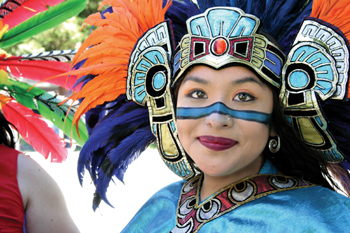
Photographs by Felipe Buitrago
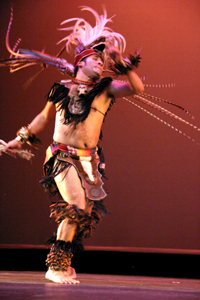
Ricardo Hernandez, also known as Ce Tochtli, dances at the Festival Floricanto Ketzalcoatl at the Mexican Heritage Theater in San Jose.
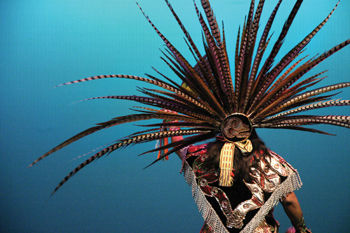
More dancing at the Festival Floricanto Ketzalcoatl.
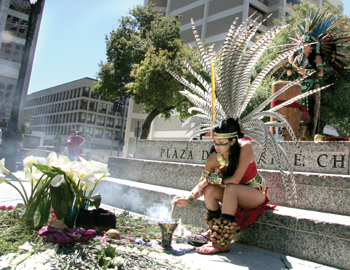
Where There's Smoke: Perla Torres performs a ritual in Cesar Chazez plaza. In 1995, protesters showed up at this site to protest the activities celebrating Aztec culture, calling the participants 'devil worshippers.'
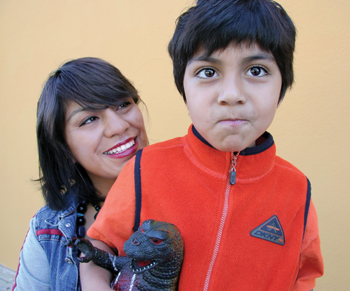
Lydia Doniz, who uses the indigenous name Tlahuixaya, with her son Balm Vargas. Tlahuixaya and her husband, David Vargas Texomazatl, now organize the annual celebration of the Aztec god Quetzalcoatl in downtown San Jose.
Send a letter to the editor about this story to letters@metronews.com.
From the July 13-19, 2005 issue of Metro, Silicon Valley's Weekly Newspaper.